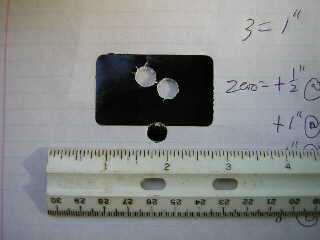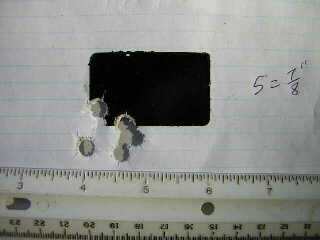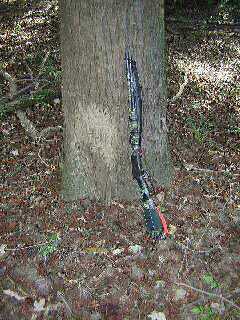Page 2
Copyright 2005 by Junior Doughty Page 1 Page 3 Page 4
Click thumbnails for full size photos
|
I was doing just fine with my Rossi 357 mag rifle using the Lee TL358-158-SWC @ 1550 fps, then here goes a couple of guys on a forum talking about getting 1700 fps with 180 gr bullets and Hodgdon's Lil'Gun powder—from 20" carbine 357 mag barrels like my Rossi's. That's honkin' for a 180 gr bullet from a 357 mag. Nothing for me to do but buy a can of Lil'Gun and start working up a load.
Bullets ready, time to load. NOTE: The following loads are safe in my rifle only and with my components only. Do not use in a pistol. Do not use mag primers.
The Hodgdon 2004 Manual showed no Lil'Gun loads for rifle but did for pistol. With a 158 gr jacketed, the manual showed a max of 18.0 grs. With a 170 gr jacketed, it showed a max of 17.0 grs. The max velocities for those pistol loads were 1577 fps and 1576 fps. I called "Help" at Hodgdon about the lack of rifle loads in the manual. "Dave" said they simply hadn't had time to test the Lil'Gun loads in a rifle. For my 165 gr cast bullet, he suggested starting lower and working up to around 16 grs. "Lil'Gun works better with lead using gaschecks and heavier bullets," he said. With the measured VMD of my Lil'Gun @ .0683 and the measured usable case capacity of my cases @ 1.02 cc, I could then divide 1.02 by .0683 and get the amount of Lil'Gun which would fill the case to the bottom of the bullet—100% loading density, in other words. The answer was 14.93 grs. So . . . I figured 15 to 16 grs of Lil'Gun with the RCBS 38-158-SWC at 165 grs would give me slight compression and probably good ignition and accuracy. Looking at the velocities in Hodgdon's pistol data, I might get 1750 - 1800 fps from my rifle. This plan was coming together. . . . So . . . I started with 15.0 grs Lil'Gun. Carefully checking each fired case because of the untried load, a large problem soon arose—pierced primers.
On the left, a pierced primer and seemingly pierced just above the A in MAGNUM. I scratched my head over this one for a while—a supposedly mild-pressure load giving signs of high pressure. I finally gave up in disgust and stopped using both Lil'Gun and the RCBS bullet. I went back to the Lee TL at 1550 fps. Then, accustomed to looking at case heads after recently seeing pierced primers, I looked at a Lee TL low pressure 1550 fps case head. The primer was pierced! I was dumbstruck. To make a long story short, I wasted many hours and bullets and lots of powder until I wondered why the primers were not pierced by the firing pin. I had seen pierced primers before—all pierced in the firing pin indentation.
I really did some head scratching then! But it finally struck me—the primers were more than 20 years old, the boxes marked 90¢. And for at least 10 of those years I stored the primers in an un-airconditioned, un-heated room in my dad's old house here in high humidity Louisiana. All the boxes contained a few primers with verdigris-like corrosion and some in which the little paper cup under the anvil looked like it had skin cancer, i.e., barely visible holes eaten into the paper. As I used them, I sorted through each box and removed the visibly bad primers. Obviously, some contained invisible corrosion which had eaten into the walls of the primers. Alas, I had 4,000+ ruined primers. . . . I bought a new box of CCI 500 primers—$2.95—and the pierced primer problem disappeared. Time to load . . . again.
Average velocity with 16.0 grs Lil'Gun = 1817 fps. Average groups measured 5 shots in around 1" at 25 yards. That was more than enough velocity and accuracy with a 165 gr cast bullet, especially compared to the Lee TL 156 gr bullet at 1550 fps and with groups around 2". Here we see the final sight-setting group for the 165 gr bullet at 1817 fps. It's zeroed about 1/2" high at 25 yards or for dead-on at 75 yards. The RCBS bullet load data:
Below, see the exterior ballistic results of both loads zeroed at 75 yards:
If you'll notice, there's not much difference in the 100 and 125 yard Point Of Impact of each bullet/load although the edge goes to the RCBS bullet. But the RCBS bullet has more energy at 100 yards, 626 fpe, than the Lee bullet has at 50 yards, 599 fpe. And comparing energy at 100 yards, the RCBS bullet/load is almost 40% more powerful. It didn't take a genius to figure out which bullet/load was better for hogs and deer—I zeroed the Rossi for the 1817 fps RCBS/Lil'Gun load. I decided to leave it there until the weather turned too warm to shoot hogs and beer can season opened.
It shot much better groups with the new primers, as you can see if you remember the circa 2" groups it shot with the old primers. In conclusion, give Lil'Gun and heavy bullets a try in your 357 mag rifle. It makes the 357 mag a much better deer round. And be careful how you store primers. . . .
I suspect that bullet could go end-to-end through a 200 lb hog. Stay tuned to the Frugal Outdoorsman for the story. . . .
|
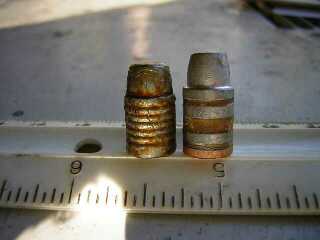
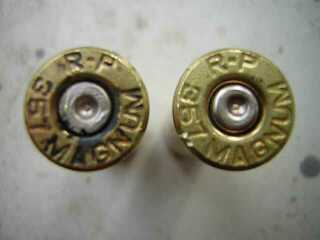
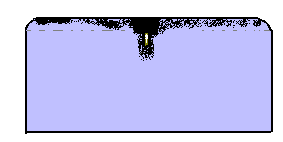 I ran a pierced-primer case through the de-capping die and caught the fired primer. Looking at it under a powerful magnifying glass, I could see a little burned through hole—in the side of the primer and not in the rounded edge. This bad, off-color graphic shows the location of most of the holes. Some of the burned through holes were even lower.
I ran a pierced-primer case through the de-capping die and caught the fired primer. Looking at it under a powerful magnifying glass, I could see a little burned through hole—in the side of the primer and not in the rounded edge. This bad, off-color graphic shows the location of most of the holes. Some of the burned through holes were even lower.